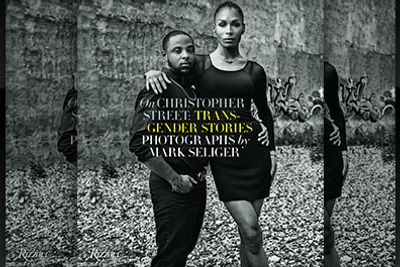By Terri Schlichenmeyer, March 2017 Web Exclusive.
Everybody, as they say, has a story to tell. An ancestor was captured in an early war. Parents who overcame adversity in a new country, a health scare, a welcome blessing, a lucky streak, a chance meeting – we all have our tales to share. And in On Christopher Street: Transgender Stories photographs by Mark Seliger, you’ll read a few.
Where would you go if you just wanted to be yourself?
If you are transgender and living in or near Manhattan, you’d go to Christopher Street in the West Village. There, you could find support, advice, community or family, if you needed it. Recently, you might have also run into the photographer behind this book, who says in a brief statement that he noticed the “freedom of expression and gender identity” that was once abundant is “vanishing” from the area. High-end condos, cafes, and restaurants are moving in and the trans community is being pushed aside; here, Seliger put a marker on it before it’s gone.
“… I realize that everybody has a trans story, that being trans is something that affects all of us,” he says, using his camera as storyteller.
Being in prison as a trans woman, says one photo subject, is like being “caged.” You don’t belong with the men. They won’t put you in the women’s lock-down. Everybody knows what’s going on and sometimes, the guards have one more slap-down in store for you just before you’re released.
Many stories begin with “I was four” or five or eight when the teller realized that they were in the “wrong body.” Families were supportive (or not), transitioning “is not easy,” and the decision for or against surgery is deeply personal but ultimately, it’s the “inner peace” that matters. Still, lying about being trans can backfire and even if nobody knows, there’s a “constant state of paranoia and fear” that may yet linger.
And then there’s the place itself: Christopher Street has “a dark side,” with drugs, prostitution and harassment. That means that for LGBTQ youth, which comprise 40 percent of the nation’s street kids, it isn’t always safe.
And so there I was, quietly reading On Christopher Street: Transgender Stories, when it suddenly ended! The surprise was not that it did so, but that I was so wrapped up in the inside this book that I didn’t notice the last pages approaching.
Yes, it’s that kind of thing, filled with photographical portraits that are worth the clichéd thousand words, and then some. Seliger’s subjects seem mostly well-at-ease in snapshots that feel random but natural; some people are identified, some are not, and not all of them weigh in, verbally. Those that do, tell tales that hit hard, in part because they leave readers with the sense that there’s more, but that it’s too difficult to speak.
This large-size, elegantly-presented coffee-table book is one you’ll return to again and again because what’s inside is so compelling. If it is, indeed, true what they say about everyone having a story, On Christopher Street is filled with good ones.
